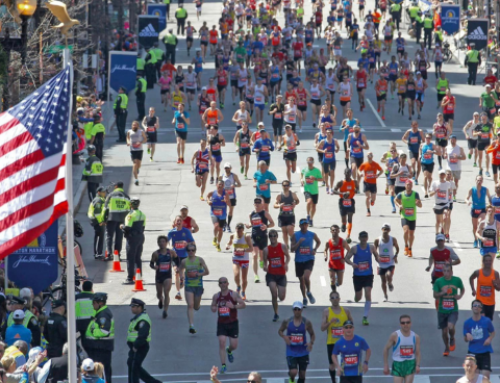GHD Sit-Ups: The Worst CrossFit Exercise?
The GHD Sit-Up is a popular CrossFit exercise for training the core and developing power on the front of the hips. It may also be one of the worst exercises you can do for your spine.
The easiest way to describe GHD Sit-Ups are to call them extreme Sit-Ups. Unlike a traditional Sit-Up, it is performed on a glute-ham machine, which takes the floor out of the equation, so you are able to lower beyond parallel and hyperextend your spine, sometimes touching the ground with your hands before extending your knees and exploding up to complete the Sit-Up.
You can watch the GHD Sit-Up demonstrated with a neutral spine here. This is actually OK. But alarms goes off when it is performed like this, which appears to be the most prevalent variation. CrossFit co-founder Greg Glassman shows the exercise being done with extension in this instructional video, as do the competitors at the CrossFit Games.
We spoke with Dr. Stuart McGill, world-renown spinal expert and a professor of spine biomechanics at the University of Waterloo (Ontario), to find out if this exercise is as dangerous as it looks to the naked eye.
What’s Wrong With GHD Sit-Ups?
They Exceed the Anatomical Limits of the Spine
The spine is a series of joints made from collagen fibers arranged in rings. It can flex, extend and laterally flex to either side within a limited range of motion, but its inherent structure is designed for constrained movement and stability. The GHD Sit-Up does not treat it this way, taking the spine to the limits of its range of motion.
“The spine is not a series of ball and socket joints,” Dr. McGill explains. “With repeated full range motions, combined with the loads experienced in this type of exercise, our work shows the fibers of the disc slowly delaminate, accelerating degenerative disc disease. The scaffolding holding the fibers together soften with each repetition, reducing the resilience of the disc to loading.”
Exacerbating the problem is the power element. Your hips are particularly suited to generate power. This ball and socket joint is able to move through a large range of motion, and the glutes and other muscle groups can quickly produce extreme force when performing activities like running or jumping. The spine, on the other hand, cannot handle large loads through the same wide range of motion.
Dr. McGill says, “There’s quite a high velocity and substantial force through a big range of motion in this exercise. You can’t perform exercises with high spine power and expect it to stay healthy. When you repeat high force and velocity through collagenous disks, they will delaminate and bulge.”
They Put Your Spine in Danger When Performing Heavy Lifts
CrossFit is known for its inclusion of Olympic lifts. Paired with the GHD Sit-Up in a WOD, the combination creates a problem.
When performing Olympic lifts—especially overhead lifts like the Snatch—your spine must be stable enough to handle the weight load. However, the anatomical issues created by the GHD Sit-Up put the spine at risk in this scenario.
“Programming of the GHD Sit-up is problematic when combined with other exercises that require stiff and tough collagen fibers, such as Olympic lifts. The GHD softens the discs, while Olympic lifts require stiff discs to safely handle the loads,” Dr. McGill says. “It would be wiser to keep a consistent approach to training to reduce the risk. In other words, avoid the GHD Sit-Up if you are training to lift heavy loads.”
You need your spine and supporting musculature to be at full strength to protect your back—especially from high-rep Olympic lifts. “Choose exercises that augment one another. Injury risk is increased if one exercise requires high loads and stiffness and the next one creates spine mobility and soft joints,” McGill adds.
RELATED: Why You Should Think Twice Before Doing CrossFit
CrossFit Doesn’t Account for Individual Differences
Athletes come in many different shapes and sizes. Some are predisposed to excel at certain lifts, like the Squat, while others are better at long-distance running.
CrossFit WODs are standardized, and they often fail to assess individual differences and needs. Yes, there are some exceptions, but this is commonplace. And when it comes to the spine, ignoring individual differences can be catastrophic.
Dr. McGill explains that some individuals have a thick spine, like a thick branch. It breaks with a small bend. Others have a thin spine, which can easily bend like a thin branch. He says that the GHD Sit-Up “will create damage much more quickly in a larger and thicker spine. This implies that certain members of the population are at particular risk. If you take a thick-spined NFL lineman and gave him this exercise, he is going to break into pain very quickly. In contrast, if you take a slender-spined person who doesn’t have to deal with those magnitudes of loads, they will be healthy a lot longer. Their spine has less stress in bending.”
They Exceed NIOSH Safety Limits
The National Institute of Occupational Safety and Health (NIOSH) determined a limit for low-back compression during repeated movements. “Exceeding this limit has been shown to accelerate the onset of disabling back pain,” says Dr. McGill.
Dr. McGill’s work has shown that when an average person does a regular Sit-Up, it’s on the verge of exceeding the limits. That’s why the trend for core training favors stability movements based on anti-extension and anti-rotation—widely accepted by the strength and conditioning community. The GHD Sit-Up goes completely against the grain, adding more spinal range of motion.
As a matter of fact, Dr. McGill actually takes patients through a similar type of move to diagnose their sources of back pain. He has individuals place a barbell on their back as if performing a Back Squat. They stand up straight and tilt their pelvis anteriorly and posteriorly to fully extend and flex their back. After a few reps, if they have a motion-related spine problem they will experience pain.
Dr. McGill concedes that some elite athletes can exceed the NIOSH limits when competing in their sport. But he adds, “The wise athletes increase their tolerable training volume by avoiding spine stress from bending, and in turn enhance their athleticism.”
Conclusion
You always need to ask yourself whether the reward is worth the risk. If you use CrossFit as a workout program, the answer is always no.
If you’re a CrossFit athlete competing, you need to perform the move since it’s part of the Games. But, given that GHD Sit-Up is indeed dangerous, CrossFit should re-evaluate its inclusion in their training program.
RELATED: Addressing the Biggest Safety Threat in CrossFit Boxes
RECOMMENDED FOR YOU
MOST POPULAR
GHD Sit-Ups: The Worst CrossFit Exercise?
The GHD Sit-Up is a popular CrossFit exercise for training the core and developing power on the front of the hips. It may also be one of the worst exercises you can do for your spine.
The easiest way to describe GHD Sit-Ups are to call them extreme Sit-Ups. Unlike a traditional Sit-Up, it is performed on a glute-ham machine, which takes the floor out of the equation, so you are able to lower beyond parallel and hyperextend your spine, sometimes touching the ground with your hands before extending your knees and exploding up to complete the Sit-Up.
You can watch the GHD Sit-Up demonstrated with a neutral spine here. This is actually OK. But alarms goes off when it is performed like this, which appears to be the most prevalent variation. CrossFit co-founder Greg Glassman shows the exercise being done with extension in this instructional video, as do the competitors at the CrossFit Games.
We spoke with Dr. Stuart McGill, world-renown spinal expert and a professor of spine biomechanics at the University of Waterloo (Ontario), to find out if this exercise is as dangerous as it looks to the naked eye.
What’s Wrong With GHD Sit-Ups?
They Exceed the Anatomical Limits of the Spine
The spine is a series of joints made from collagen fibers arranged in rings. It can flex, extend and laterally flex to either side within a limited range of motion, but its inherent structure is designed for constrained movement and stability. The GHD Sit-Up does not treat it this way, taking the spine to the limits of its range of motion.
“The spine is not a series of ball and socket joints,” Dr. McGill explains. “With repeated full range motions, combined with the loads experienced in this type of exercise, our work shows the fibers of the disc slowly delaminate, accelerating degenerative disc disease. The scaffolding holding the fibers together soften with each repetition, reducing the resilience of the disc to loading.”
Exacerbating the problem is the power element. Your hips are particularly suited to generate power. This ball and socket joint is able to move through a large range of motion, and the glutes and other muscle groups can quickly produce extreme force when performing activities like running or jumping. The spine, on the other hand, cannot handle large loads through the same wide range of motion.
Dr. McGill says, “There’s quite a high velocity and substantial force through a big range of motion in this exercise. You can’t perform exercises with high spine power and expect it to stay healthy. When you repeat high force and velocity through collagenous disks, they will delaminate and bulge.”
They Put Your Spine in Danger When Performing Heavy Lifts
CrossFit is known for its inclusion of Olympic lifts. Paired with the GHD Sit-Up in a WOD, the combination creates a problem.
When performing Olympic lifts—especially overhead lifts like the Snatch—your spine must be stable enough to handle the weight load. However, the anatomical issues created by the GHD Sit-Up put the spine at risk in this scenario.
“Programming of the GHD Sit-up is problematic when combined with other exercises that require stiff and tough collagen fibers, such as Olympic lifts. The GHD softens the discs, while Olympic lifts require stiff discs to safely handle the loads,” Dr. McGill says. “It would be wiser to keep a consistent approach to training to reduce the risk. In other words, avoid the GHD Sit-Up if you are training to lift heavy loads.”
You need your spine and supporting musculature to be at full strength to protect your back—especially from high-rep Olympic lifts. “Choose exercises that augment one another. Injury risk is increased if one exercise requires high loads and stiffness and the next one creates spine mobility and soft joints,” McGill adds.
RELATED: Why You Should Think Twice Before Doing CrossFit
CrossFit Doesn’t Account for Individual Differences
Athletes come in many different shapes and sizes. Some are predisposed to excel at certain lifts, like the Squat, while others are better at long-distance running.
CrossFit WODs are standardized, and they often fail to assess individual differences and needs. Yes, there are some exceptions, but this is commonplace. And when it comes to the spine, ignoring individual differences can be catastrophic.
Dr. McGill explains that some individuals have a thick spine, like a thick branch. It breaks with a small bend. Others have a thin spine, which can easily bend like a thin branch. He says that the GHD Sit-Up “will create damage much more quickly in a larger and thicker spine. This implies that certain members of the population are at particular risk. If you take a thick-spined NFL lineman and gave him this exercise, he is going to break into pain very quickly. In contrast, if you take a slender-spined person who doesn’t have to deal with those magnitudes of loads, they will be healthy a lot longer. Their spine has less stress in bending.”
They Exceed NIOSH Safety Limits
The National Institute of Occupational Safety and Health (NIOSH) determined a limit for low-back compression during repeated movements. “Exceeding this limit has been shown to accelerate the onset of disabling back pain,” says Dr. McGill.
Dr. McGill’s work has shown that when an average person does a regular Sit-Up, it’s on the verge of exceeding the limits. That’s why the trend for core training favors stability movements based on anti-extension and anti-rotation—widely accepted by the strength and conditioning community. The GHD Sit-Up goes completely against the grain, adding more spinal range of motion.
As a matter of fact, Dr. McGill actually takes patients through a similar type of move to diagnose their sources of back pain. He has individuals place a barbell on their back as if performing a Back Squat. They stand up straight and tilt their pelvis anteriorly and posteriorly to fully extend and flex their back. After a few reps, if they have a motion-related spine problem they will experience pain.
Dr. McGill concedes that some elite athletes can exceed the NIOSH limits when competing in their sport. But he adds, “The wise athletes increase their tolerable training volume by avoiding spine stress from bending, and in turn enhance their athleticism.”
Conclusion
You always need to ask yourself whether the reward is worth the risk. If you use CrossFit as a workout program, the answer is always no.
If you’re a CrossFit athlete competing, you need to perform the move since it’s part of the Games. But, given that GHD Sit-Up is indeed dangerous, CrossFit should re-evaluate its inclusion in their training program.
RELATED: Addressing the Biggest Safety Threat in CrossFit Boxes










